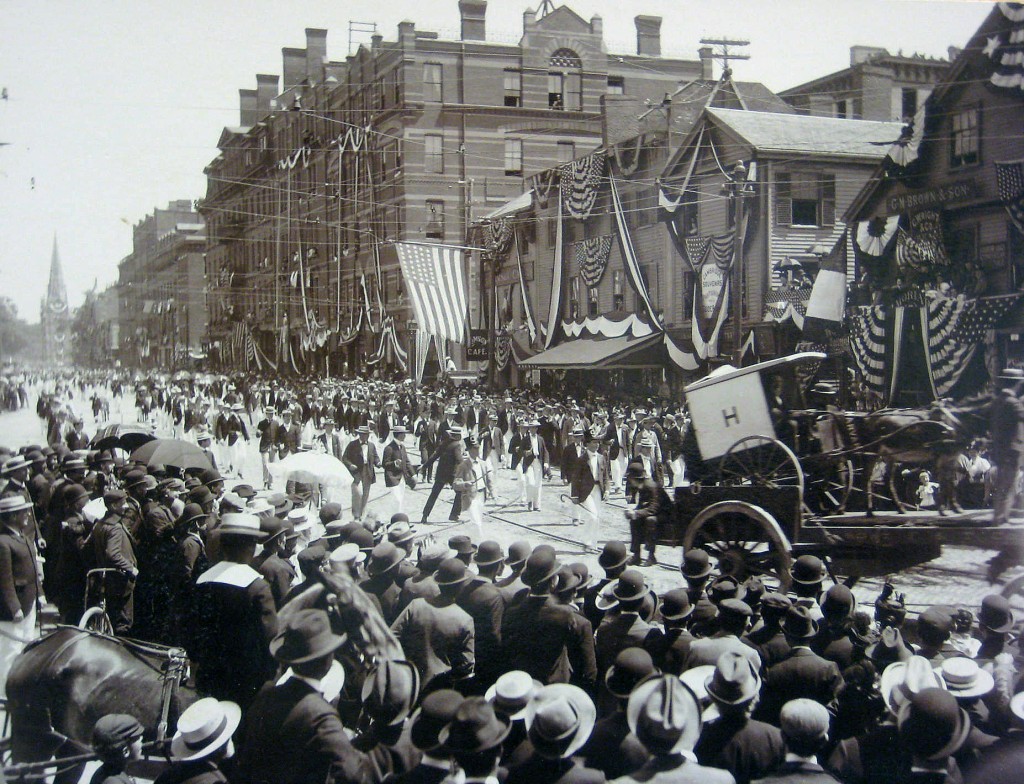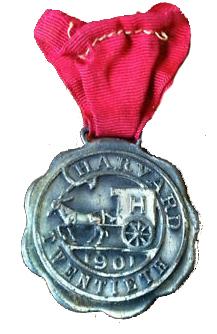 Many of Boston’s suburbs (including the house of your favorite editor) may be under snow and without power from the worst October snow storm ever, but still, what’s a little weather?
Many of Boston’s suburbs (including the house of your favorite editor) may be under snow and without power from the worst October snow storm ever, but still, what’s a little weather?
From our old House to yours, a very HAPPY HALLOWEEN!
 Many of Boston’s suburbs (including the house of your favorite editor) may be under snow and without power from the worst October snow storm ever, but still, what’s a little weather?
Many of Boston’s suburbs (including the house of your favorite editor) may be under snow and without power from the worst October snow storm ever, but still, what’s a little weather?
From our old House to yours, a very HAPPY HALLOWEEN!
As part of my Six Buildings That Shaped Harvard History tour for the HAA coming up on the 15th and again on the 26th, I’ve been doing quite a bit of research on the development of Harvard’s architecture over the years. As part of this review I came across a remarkable photo, which I wanted to share with you. It’s a view of Harvard looking south from the newly built tower of Memorial Hall, taken in 1874.
(Click on the photo to expand, then use your browser controls to zoom in even more. The photo is incredibly crisp and detailed – you can even see the masts of the cargo vessels on the Charles peeking (or peaking!) out over the rooftops. Even laundry drying in the backyard! NB: The names in parentheses indicate “future site of”.)
It takes a few minutes to get your bearings, as the landscape has so changed so dramatically, but this is almost exactly the Harvard that TR would come to know two years later. (The tree-lined street to the left is Quincy Street; the horizontal cross is Mass Ave.) What’s remarkable is how small the College remained up until that time – not terrifically different from the Colonial college of a hundred years earlier. A quaint Professors’ Row, a small Gothic Library, the odd hall and dormitory – just like many private colleges scattered across the country even today. Interesting too is the welter of tiny frame dwellings that cluster the semi-industrial riverfront. These parcels would have to be acquired one at a time over the next forty years in order to build the Georgian River Houses we all know so well. (Not so surprisingly, it was a private Foundation of far-sighted alumni, concerned that the College would have no room to grow, who started buying up the riverfront property a decade before the Administration came to the same conclusion. The parcels were later transferred to the College at cost.) Of dear Adams, only Apthorp House suggests the structures to come. (TR’s own lodgings, in a simple white frame structure long demolished to build the I.A.B (Malkin), is one of the jumble of frame buildings visible beneath the word “Eliot.”
What’s fascinating about all this, and what forms the basis of my tour, is how much Harvard’s architecture charts the College’s growth from tiny divinity school in the wilderness to worldwide center of learning, and how, given slightly different circumstances and the odd historical twist, Harvard might have turned out VERY differently from the one we know today.
While the tour on the 15th is sold out, the one on the 26th still has some spots, so do join us if you are in Cambridge.
Some People Read History. Others Make It.
Come make a little history: support the FDR Suite Foundation!
Greetings All!
Just a very quick note to welcome in the new semester, and let you know of two developments.
First, a brand new tour:
( If for any reason, this link doesn’t work for you, you may watch this video on the Vimeo site, directly HERE)
For an I-Phone friendly version, click HERE
This footage is part of a much longer documentary we are putting together on FDR’s Harvard and the Restoration of the Suite, which will be hopefully ready this fall.
Secondly, I would like to appeal to all of you to help us put our financial house in order. As you know, several months back we launched a $50,00 capital campaign. So far, we have raised only $5000. Part of our problem is that we’ve always accepted donations on a rolling basis, rather than asking for your continuing generosity annually, which means that while some of you have given quite recently, many of you have given generously a year, or two or three back.
We’d now like to press a giant reset button, and love for you to become annual members, contributing whatever amount you’re comfortable with, $100, $250, $500, $1000, or more, on an annual basis each September. The details of the various membership levels are available HERE, where you can also donate securely online. These annual memberships would help tremendously in evening out our finances, and allow us to plan our educational outreach programs more cohesively. Already this fall we’re leading HAA walking tours, organizing student trips to Brimfield, and planning for two to three new Fireside Chats, as well as another issue of the GoldCoaster, on top of the already promised documentary.
All these activities take funds, and we could really use your help. As always, your contributions to the Foundation are deductible to the extent allowed by law.
Thanks as always for your continuing generosity.
Michael
Some People Read History. Others Make It.
Come make a little history: support the FDR Suite Foundation!
It’s been said you can tell an age by its advertising, and to the extent we possess the records, the adage seems to be true: ancient graffiti on the walls in Pompeii bring 2000-year-old elections alive like no tract from Cicero ever could; miniature manikins – dressed in the latest crinoline and lace and sent from Paris to the Colonies as ads for the newest fashions – reveal more about 18th century costume than a whole page of pallid text.
Fortunately for us, the world of FDR’s Harvard is ripe with similar examples that give tone and timbre to the age – if you know where to look. To that end, we’ve been acquiring actual periodicals from January to June 1904 for the Suite (including, too, a spectacular bound copy of the Crimson for 1900-1901) so that a visitor might casually pick up Harpers Magazine or Colliers, and flick through the pages just as if they had popped in for a few hours in May of 04.
I wanted to show you a few of my favorites pieces from this collection, which to my mind at least, make you realize how much the world has truly changed.
This first one is a classic.
What else can I say? Papa told me so!
We tend to forget too that personal hygiene has been revolutionized in the last century. Imagine a time with no deodorants?
And, as we are blistering through another baking summer, how about a world of binding clothes and no air conditioning?
 And here’s something that totally fascinated me. Throughout the Crimson pages, I found example after example of this ad:
And here’s something that totally fascinated me. Throughout the Crimson pages, I found example after example of this ad:
Beyond the name, which I thought totally cool for a cigarette (Egyptian Deities was the model for an upstart American knock-off, Camels) there was the fact that many of these ads simply proclaimed “Egyptian Deities” without a single word of explanatory byline – the brand was so famous at Harvard to need no further introduction.
(Just like another ad I found again and again in the Crimson: Harvard University Training Tables: 15 Bow Street. YOU ALL KNOW YOUNG! “No I don’t know Young,” I’m grumbling to myself, frustrated, “tell me who he is!”).
In this case however, a thought occurred: Lapes and Frank both smoked. Surely there would have been cigarettes in the Suite. Could some of these Deities cigarettes have possibly survived from that time? If so, what a coup to track some down!
Well, a quasi-coup, as it turned out…
Sans cigarettes, but an actual 1900 Deities tin nonetheless, procured on EBay for $15, now destined for the Suite!
How’s that for divine intervention?
Or perhaps, more aptly, ad inspiration?
All brought about by folks like you.
Some People Read History. Others Make It.
Come make a little history: support the FDR Suite Foundation!
Just a quick note from 101º Cambridge to let you know of some of the improvements to the FDR Suite web site. The menus and content have been entirely re-arranged and updated for ease of use, and some spectacular new content added, in particular a new version of John Bethell’s excellent 1996 article Frank Roosevelt at Harvard (and what became of him later) which paints a remarkable portrait of FDR’s often complicated relationship with Harvard, and Harvard’s oft-strained relationship with him. If you haven’t read it, you most certainly should.
Thinking cool thoughts…

John the Orangeman, Harvard's Mascot, as he appeared in FDR's day. This is the picture we have in the Suite. If you look carefully in the lower left-hand corner (this image, as all the others in the piece, can be expanded by double clicking the picture) you will see another source of John's financial success: by 1900 or so, he had moved into selling copyrighted souvenir photos.
Without fail, whenever I give a tour of the FDR Suite, someone asks me who’s that bearded man with dancing eyes, merrily peering out from the frame on the mantle piece. There’s something about the sparkle of his expression that simply captivates visitors. My inevitable reply: “That’s John the Orangeman, Harvard’s mascot. He sold fruit to the students at a time when citrus was a rarity, and become hugely popular with the undergraduates. He and his cart, pulled by a donkey named Radcliffe, were a feature of the College for over five decades.”
A thorough answer, but not a very satisfactory one. Who was this man, really, and how did he become so popular with the students? I decided to do a bit of digging in the Harvard Archives to try and find out.
Well, let me tell you: In the spirit of the soon to be demised News of the World, there seems to be more to this story than first meets the eye!
To begin with, it’s important for you to understand that John was not just popular, he was hugely popular. The archives have more than six folders of Orangeman pictures dating back to the 1870s, many of them official photos, and a whole other file of clippings, memorabilia – even two short published biographies written by former students. Here’s one of my favorite photos from the Archives collection, showing a parade passing through Harvard Square. (The view is looking east down Mass Ave. The low building right of middle is where Holyoke Center now stands. The tall building at center is extant and holds Leavitt and Peirce.)

This is a truly spectacular photo for many reasons. For one, the level of historical detail is amazing; notice, for example, the maze of telegraph and telephone wires almost clouding the sky. We forget that not everything in the "good old days" was quite so pretty. The picture is not captioned or dated, but judging from the bunting, the summer dress of the paraders, and the two top-hatted men marching behind the wagon each with a "9" on the front, I would guess this to be the late 1890s. (Again, click to expand; see reader's comment below for exact dating.) Courtesy, this and following photos: Harvard University Archives.
At first glance, this picture doesn’t seem to have much bearing on our story. But look again at the lower right side: just passing out of view, there are John and Radcliffe, cart and all, being hauled down the street on some sort of large wagon, the Victorian equivalent of a parade float.
So, famous indeed. Here’s the official bio:
Born John Lovett in Kenmere, County Kerry, into a farming family about 1833, John left Ireland during the famine, first for Boston, then later to Cambridge, where he took odd work. Then one day, finding himself with nothing to do, he went to “over an the Carmon to wartch the byes play barl.” (The transliteration of the brogue is from one of his student biographers.) Seeing that the players were thirsty after the game, he offered to fetch them a jug of water from his nearby flat (laced with “lemon” and “molasses”, as he put it) for which the students were quite graceful, requesting another. He complied, and the students, wishing to thank him, passed around a hat, collecting about two dollars, along with a suggestion that bringing fruit to their rooms later might prompt similar reward. Thus, a career was born. John began selling various small items to the students, mostly bananas and oranges. Each day he made his way into Boston to buy at the wharves. By mid-morning, basket in hand, he would be in the college yard, “depending on stray customers between the recitations and lectures; in the afternoon, if the weather was warm, he visited the ball fields; while in the evening he made his tours through the dormitories.” So grateful were the students that Class of 1881 gave him a handcart: “They warnted to give me a darnkey too but I be afraid the Farculty mek a row about havin’ ‘im in the Yard.” At first an overzealous Yard Manager prohibited the cart from entering, but petitioned by the students, the Faculty allowed finally allow John and his cart admittance – the only person ever permitted, before or since, to sell goods in the Yard. As age advanced, so did rheumatism, and seeing John in distress, the class of 1891 bought him a donkey and cart. In winter, Radcliffe the donkey pulled a small sleigh. Soon John, with or without Radcliffe, was not only selling goods but making the round of the various football games, brought by the team to locations as far away as New York, where he cheered tirelessly for his school. (On state occasions like the Harvard-Yale game, Radcliffe was decked out with special crimson bloomers.) Fame and increasing fortune brought John a wife, plus a three-story two-family in Cambridge, which amazed student visitors with its size and comforts, given his humble occupation. Stories about John abound, but an oft-quoted one was this:
One day a visitor accosted John in front of Hastings Hall, and wishing to draw him into conversation, pointed to the College seal on the iron gate and asked him what Veritas meant. John bowed respectfully and replied: “I’m not sure fr’ind, but I guess it means ‘to hell with Yale.’”
John Lovett died in 1906 at the ripe old age of 81.
That’s the official story… Neat, pat and tidy.
But why was he so popular? There were a host of other notable characters at FDR’s Harvard, but none quite so beloved. What was John’s secret? His biographers often cite to his jovial personality:
“You all know him, Old John, who is the first to welcome the Freshmen in the autumn, and the last to shake hands with the Seniors on Commencement and perhaps drink him God-speed from a flowing bowl of punch. He well remembers the time your father was in College; will tell you where he roomed, how he lived, who his friends were; perhaps he will even whisper in your ear of a narrow escape he had, in the early part of his Freshman years, from being asked to resign. Is there one who has not tasted and orange or banana from the little white handcart?”
Also to his integrity: “For those who know him well he is rather an interesting study, though his brogue is a trifle hard to comprehend at times. One of the best traits of his character is that he can never be induced to speak ill of anyone. Mingling as he does with the men of various sets and cliques, he necessarily hears more or less slander, but if asked his opinion about a man, his only comment is ‘Aw, he’s a good fellah, frind.'”
And on and on…
But then I came across one very curious sentence: “Who has not been comforted, when sorely pressed by creditors, by John’s ready willingness to trust him for any amount?”
Ah ha… The plot thickens. Perhaps it was more than just a juicy orange that gave John his appeal. Still, a bit of money-lending on the side couldn’t account for such lasting hail-and-well-met. I was about to give up, thwarted by the silence of the past, when just before the closing hour, I came across this picture stuck to the back of one of the folders. Unlike other pictures of John, many of which were “official” shots reproduced again and again, this was distinctly different, and one I had never seen before:
Again, there is no caption, other than to note that the photo came as part of the estate of a member of the class of ’01. The scene’s obviously been professionally staged in some photographer’s studio, for reasons now forgotten – perhaps as a private memento (or perhaps, even more rare, as a publicity photo for Brown of Harvard, which premiered in Boston in 1906, and in which John played a bit roll as himself, just a few months before his death.) But however clouded the origins of the picture, its subject is certainly straight-forward enough, and meant to evoke a familiar scene – at least for those in the know: a grinning student, having polished off the bottle on the table, holding a cigar large enough to choke a horse, looks gratefully at a still imbibing John the Orangeman, empty liquor bottles littering the floor and more poking from of his basket – the very one supposedly full of fruit!
Hail and well met, indeed!
So if I remind you, dear reader, that Cambridge was dry in those years, and that the only alcohol to be had was by going to Boston, does not the reason for John’s immense and continued popularity across five decades of thirsty students suddenly become crystal clear?
I’m thinking John bought more than oranges on those daily trips to the wharves, and sold more than fruit on his nightly rounds.

20-years gone but not the least forgotten: the Class of 1881 chose to feature John on its 20th Reunion Medal. Acquired just last week, the medal will hang on John's picture in the Suite.
And remember that admiring bit about John never betraying a confidence? Neither it seems, did his “byes.” In fact, the whole thing is one long inside-joke, known by all, and advertised by none, across 50 classes of Harvard men – the don’t-ask-don’t-tell of its age. If it hadn’t been for this one surviving photo, John’s open secret might be a secret still.
Of course, I can’t prove any of this.
But it fits, doesn’t it?
Can’t you just feel it?
It’s important to note that this potential revelation doesn’t at all reflect badly on John. (He wasn’t selling booze to minors. There was no drinking age in those days, and the only law he was skirting was the selling of liquor in the town of Cambridge.) Nor does this diminish in any way the genuine regard generations for Harvard men had for this beloved character. On the contrary. In the end what we get is the image of a cunning Irish Robin Hood fighting to outwit the dastardly Sherwellian forces of the Cambridge establishment for the benefit of the (not so) poor inhabitants, and I’ll admit, if true, this vision brings me a quiet satisfaction. Often the view of our Harvard past becomes too perfect, too polished, too mannered. The memories are all noble, the deeds all gallant, the people, upright & upstanding. This little bit of Irish roguery, abetted and encouraged by grateful generations of scheming undergraduates, is just the kind of thing to add a welcome bit of humanity to the tale.
So, here’s raising a glass to you, John.
Some People Read History. Others Make It.
Come make a little history: support the FDR Suite Foundation!